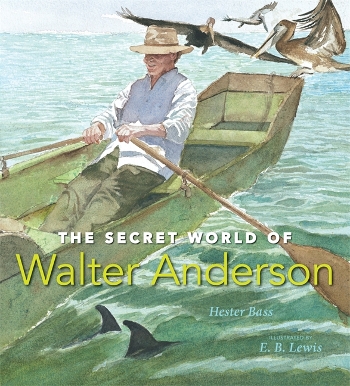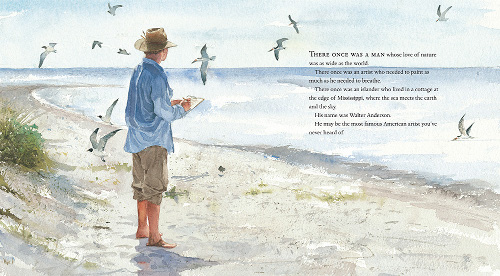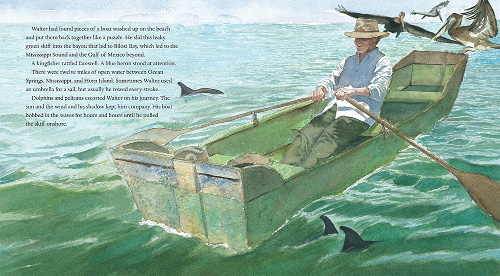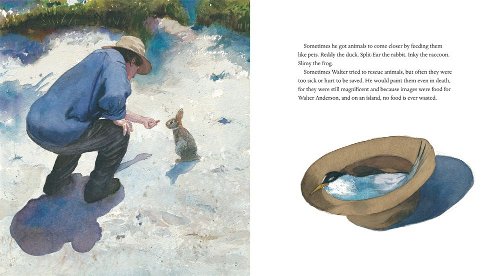When Images Are Food: The Secrets of Walter Anderson — With a Visit from E.B. Lewis
and Hester Bass
 September 30th, 2009 by jules
September 30th, 2009 by jules
(Click to enlarge spread.)
Several weeks ago, I blogged about a few new picture book biographies that made me happy. I was eager then to tell you about the title I’m featuring today, but I wanted to wait a bit to secure some spreads from it to share with you. This is, hands down, one of my favorite picture books from this year, and it seems to have come out of nowhere and surprised me. It’s called The Secret World of Walter Anderson (Candlewick, September 2009), it’s by an author with whom I was not previously familiar, Hester Bass, and it’s about “the most famous American artist you’ve never heard of,” as Bass puts it. The book was illustrated by the one and only E.B. Lewis, whose work I’ve long adored.
 “There once was a man whose love of nature was as wide as the world,” the book opens. “There once was an artist who needed to paint as much as he needed to breathe.” Meet Walter Anderson, born in 1903, who lived in a cottage along the Mississippi Gulf Coast. An artist who saw his work as an adventure, he had one room in his cottage to which no one else was ever invited: “He didn’t let anybody in there—maybe a possum or a mouse, but not his wife or his children. Nobody. Ever. That was his little room.” He’d pin a note to that cottage door and often head out to the deserted Horn Island: “…{F}or Walter, to paint on Horn Island was to be in paradise.” He’d scrounge for food, use his boat for shelter, write in his journals, and “draw and paint all his {animal} friends on Horn Island from sunrise till after nightfall…Some people called him crazy for living like a hermit just to paint fish and animals and birds and plants. But Walter Anderson spent some of the happiest times of his life on Horn Island.” Bass devotes the story to his trips to the island and his life of solitude and wonderment there.
“There once was a man whose love of nature was as wide as the world,” the book opens. “There once was an artist who needed to paint as much as he needed to breathe.” Meet Walter Anderson, born in 1903, who lived in a cottage along the Mississippi Gulf Coast. An artist who saw his work as an adventure, he had one room in his cottage to which no one else was ever invited: “He didn’t let anybody in there—maybe a possum or a mouse, but not his wife or his children. Nobody. Ever. That was his little room.” He’d pin a note to that cottage door and often head out to the deserted Horn Island: “…{F}or Walter, to paint on Horn Island was to be in paradise.” He’d scrounge for food, use his boat for shelter, write in his journals, and “draw and paint all his {animal} friends on Horn Island from sunrise till after nightfall…Some people called him crazy for living like a hermit just to paint fish and animals and birds and plants. But Walter Anderson spent some of the happiest times of his life on Horn Island.” Bass devotes the story to his trips to the island and his life of solitude and wonderment there.
Eventually, after Walter’s death in 1965, his wife unlocked the mystery room in his cottage and ventured inside — “and what she saw took her breath away…There was art everywhere.” Indeed, inside this one room was art he had created and kept hidden, kept to himself. The walls were covered with paintings of his Gulf Shore adventures, birds and other animals, and a “giant zinnia on the ceiling.” In a fascinating author’s note at the book’s close, Bass describes in more detail the events of Walter’s life and the events after his death, including the unfortunate storm surge from Hurricane Katrina that “took much of the legacy of the Anderson family out to sea.”
Have I mentioned I love this book? I’ll say it again, though: I love the writing, and I love the art. Publishers Weekly calls this a “powerful tribute to the lengths artists will go for their passions” and Kirkus, a “gorgeous chronicle of a versatile southern American artist.” A more fitting illustrator, I think, could simply not have been chosen, too. Lewis’ luminescent watercolors perfectly capture the beauty of the island and Anderson’s devotion to it. When I asked E.B. Lewis about this title, he said that
“{s}ince watercolor was {Anderson’s} medium-of-choice, as is mine, I think this makes a great marriage,” adding:
…I am always inspired by the text first; however, this project was extremely special, because here was a chance to celebrate a great American artist. An opportunity to enrich a child’s life with art…. For me, as an artist, the process is far more important that the product. In researching Walter Anderson, I had the wonderful opportunity to visit his home, family, and the island that he loved, although much of that had been destroyed by Hurricane Katrina. This provided the nuance that I need to bring his world to life. I had a grand time working on this project.
I also had a chance to ask the author, Hester Bass, about her work on this book. Without further ado, here she is, and I thank her—and E.B.—for stopping by.
until he pulled the skiff onshore.”
(Click to enlarge spread.)
7-Imp: I know you mention this in the Author’s Note, but can you talk a bit—for those folks who haven’t read the book—about how and when your admiration for Walter’s work began?
Hester: Some time in 1982, a friend in Mississippi sent us an issue of Horizon magazine with an article about Walter Anderson. I was instantly enchanted. His work has a liveliness to it that drew me in, his writings are equally absorbing, and his life was the stuff of legend. I wanted to hop in the car and drive down to Ocean Springs, Mississippi, to see everything for myself. Which is wonderfully mysterious, because some readers have told me that this book had the same effect on them. That’s one of the best reviews I could ever hope for.
Fast-forward nearly fifteen years, and my family moves to Ocean Springs, when my husband becomes the director of the Walter Anderson Museum of Art. We meet the Anderson family, visit Horn Island, and simply enjoy being surrounded by the same environment that so inspired him. My children were young, and those were halcyon days. The more I saw of Walter Anderson’s work, the more deeply I admired it.
7-Imp: You wrote in the book (your back-flap bio) that you were once asked what story you most wanted to publish — and that this was it. When did the idea of writing about Walter first come to you?
Hester: In the late 1990s, I was working as a storyteller, performing fairy tales and original material. When school groups would come to the museum, I often told them the story of Walter Anderson’s life. Some of his adventures sound like mythology, but they’re true, and the children were fascinated. Fidgety kids would relax into the tale of a man who drew with crayons as expertly as he did with ink, who rode a bicycle but didn’t drive a car, who occasionally ate what washed up on the beach, and made friends with the animals on Horn Island.
I wrote the first draft in 1999. I find Anderson’s art and writings, like nature itself, endlessly refreshing and wanted to share his story in the same way that one wants to tell friends about a fabulous restaurant or an engaging film. There were many books about Anderson for adults, but almost nothing for children. In workshops, writers are often told to “write the story that only you can write.” I took that advice to heart, and was compelled to tell the story of Walter Anderson.
7-Imp: Tell me about your research for this book.
Walter Anderson, and on an island, no food is ever wasted.”
Hester: I’ve heard some of the stories about Walter Anderson for over twenty-five years, so I had to separate the myth from the man. I read the books about Anderson and his art repeatedly and took notes, which I collected and collated and compared. I concentrated on the books that are as close to primary resources as I could get — The Horn Island Logs of Walter Inglis Anderson, edited by Redding S. Sugg Jr., and Approaching the Magic Hour, the memoir by his wife Agnes Grinstead Anderson, who was a superb writer. It’s my good fortune to be acquainted with the Anderson family, as well as a former curator for the Walter Anderson Museum of Art, and they helped me refine the manuscript for accuracy.
Additionally, E. B. Lewis and I enjoyed a rare author-illustrator collaboration on this project. We both went to Mississippi in the summer of 2008 and visited the places where Walter Anderson lived and worked, including Horn Island. E. B. works in the classic style of posing models for reference photography, so we set up each of the scenes in the book, working from his sketches. Lucky for us, two of Walter Anderson’s children agreed to pose as their parents (the resemblance is striking), and his other two children helped us gain access to his cottage and get to Horn Island.
We’re so grateful for the participation and assistance of the Anderson family and the staff at the Walter Anderson Museum, who helped me find many of the photographs of Anderson’s work that illustrate the Author’s Note. Working with everyone at Candlewick has been a pleasure and confirmed my belief that creating a picture book is akin to making a film – many hands work together to craft something wonderful.
7-Imp: I think the biography is so beautifully-written. Can you talk a bit about your writing process? How many drafts did you go through to get to this well-crafted book you offer readers now?
Hester: First of all, thank you for the compliment! I remember vividly my first trip to Horn Island, and I wanted to share that sense of an adventurous journey and depict art as a way of life. My first draft was about 2,500 words and then the distillation process began, trying to convey someone’s life story in as few words as possible. I really couldn’t tell you how many drafts I went through. It was a lot though — a whole lot.
After trying it several different ways, I decided to focus on the last part of his life, when he was spending so much time on Horn, for the main story, telling the rest in the Author’s Note. Anderson’s work falls into three distinct periods—Ocean Springs, Oldfields, and Horn Island—and he is best known for the Horn Island watercolors. Plus, when I would tell his story to the school children visiting the museum, that’s the part they liked best, when he was living under his boat on the beach and painting the wildlife.
As to my writing process, while I would certainly enjoy the luxury of spending entire days writing, like most people, I have commitments to family and community. My goal is to spend three or four hours a day writing, then throw in a little time on marketing.
Lately, I’ve put in a lot of hours on marketing efforts to get the word out and create what I’m calling a Shoestring Tour. That’s actually a term used by SIBA, the Southern Independent Booksellers Alliance, and it’s appropriate for what I’m doing, which is seeing how much I can tour on as little money as possible. These days authors have to do everything they can to compete in the marketplace, and I truly enjoy author visits and signings and blog tours -– thanks for having me!
7-Imp: You’re welcome and my pleasure.
What was it like for you to see E.B. Lewis’ art work for the book for the first time?
Hester: Very emotional. Just seeing the rough sketches brought tears to my eyes, to see my manuscript coming to life, especially since E. B. Lewis was my first choice for illustrator. He’s a skilled watercolorist, and I felt he would understand Walter Anderson’s journey as an artist. I had found quotes online attributed to E. B. that I could easily have believed had been said by Walter Anderson; they seem to share a certain sensibility when it comes to nature as subject matter.
I admire E. B.’s marvelous treatment of water and changing light conditions, so the cake was when he came on board, and the icing was becoming friends on our trip to Ocean Springs. I was absolutely thrilled to see the finished sketches, and then the proofs, and then the book itself. E. B. also made a special effort to make sure I saw the original paintings, which were like a string of pearls one after the other. I love the cover; it captures the joy Walter felt on those journeys to Horn.
7-Imp: What has the response to the book been from Walter’s family?
Hester: From what I hear, they are pleased with it, which makes me happy. I wanted it to be a book that they would feel proud to read to his great-grandchildren. I hope that’s true.
7-Imp: What’s next for you? Any books you are working on now that you can talk about?
Hester: What’s next is a lot of traveling in support of The Secret World of Walter Anderson. I enjoy getting out there and meeting people who love art and books, so I’ll be appearing at schools, libraries, museums, conferences, and bookstores. My schedule is on my website.
I enjoy reading picture book biographies, so I’m working on more of those, as well as some fiction. I’ve started a somewhat philosophical YA and a middle grade novel set in an alternative past. Writing is hard work, but it’s playing with words. It’s a constant search for those words that play well with others, and that is so much fun.
THE SECRET WORLD OF WALTER ANDERSON. Text copyright © 2009 by Hester Bass. Illustrations copyright © 2009 by E.B. Lewis. Reproduced by permission of the publisher, Candlewick Press, Somerville, MA.




*sigh*
So beautiful.
It’s so sad to me that this man’s mystery room is mostly gone, but probably he understood that the gifts from the sea go back to the sea; the tide rises, and eventually the water covers the land. But it’s hard to imagine that his magic has fully vanished from the world, and indeed we have it in the work of E.B. Lewis. This was a truly lovely post.
Thanks, Tanita!
Here’s a bit more on the devastation as a result of Katrina: What happened was that, in 1928, his older brother founded their family business, Shearwater Pottery, and Walter and his wife moved into the cottage there after they got married. After Katrina, that pottery showroom and some workrooms were gutted. The family vault, including their personal collection, was flooded. Walter’s cottage was ruined. Fortunately, the artwork at a museum established in his honor (in downtown Ocean Springs) was safe.
Since then, they’ve rebuilt the pottery and righted the cottage (which had been knocked off its foundation). Very sad, huh?
I have this book to review as well – it’s so lovely. And E.B. Lewis’s illustrations are swoon-worthy. Love the interview with Hester, though – great content, as always!
Kelly, isn’t it, though? One of my favorite picture books from this year. And I always like posting about Southerners!
Oh Jules, this is fabulous! Sorry I’m on the late train today, but I just read this wonderful interview and am so excited because I had just finished reading about Anderson in a publication I got from my alma mater. There is an exhibit which will be traveling in 2010 to libraries and schools called “Walter Anderson and World Literature”, which is a 60-piece display of his art which was inspired by great works of literature (including Alice in Wonderland).
I hope the exhibit comes to the West coast someday, but in the meantime, I am definitely going to get Hester and E.B.’s book – how breathtaking are those illustrations, and what a fantastic, important story! Thanks to Hester and E.B. for their beautiful work of art, and for introducing Anderson’s art to so many.
Jill, that’s pretty great. I hope the exhibit comes to Tennessee.
I loved this one as well – reviewed it over at Voices of NOLA a couple of months ago. My son was head over heels for Walter – and we loved seeing the room at the end (the afterword pages are really really good).
The room is okay though, isn’t it? I thought I had read that it was moved to town and wasn’t damaged. (Need to get my copy out and check).
And wow Jill! I hope that exhibit comes west as well!
Colleen, you’re right! This from the author:
Not only is E.B. a gorgeous artist, he is genuinely lovely (and funny, don’t forget funny!) man.
Jane
I am in love with this book…just as I am in love with its subject. I lived in Hattiesburg, MS, for four years while attending college. One of my roommates took me to the Walter Anderson museum and all it took to start my love affair was one step into the cottage. Thanks so much to Hester and E.B. for doing his story justice.
[…] When Images Are Food: The Secrets of Walter Anderson — With a Visit from E.B. Lewisand Hester … September 30th, 2009    by jules […]
I can’t wait to see this book! The paintings are so lovely and full of light! Kudos to E.B.
this is going to help me so much on my art paper that I have to do! I moved recently to Illinois, but I was raised in Long Beach, Ms. I have been to the museum and it was wonderful. Everyone here at my school has NEVER heard of W. A. I was very depressed, so i decided to do it on him.
Thank you for this post – he’s such an inspiration for us.
“Art is incredible stuff –– not for itself, but in changing the artist’s relation to other things––perspective.”
– Walter Inglis Anderson
Very interesting and informative web site about Walter Anderson. Glad I came upon this. As an art major and water colorist for an art gallery, I used to wonder what Mr. Anderson and I could talk about if I had met him back in his day. Interesting thought. I am ready to head back to Ocean Springs, Mississippi. Mike Koskie